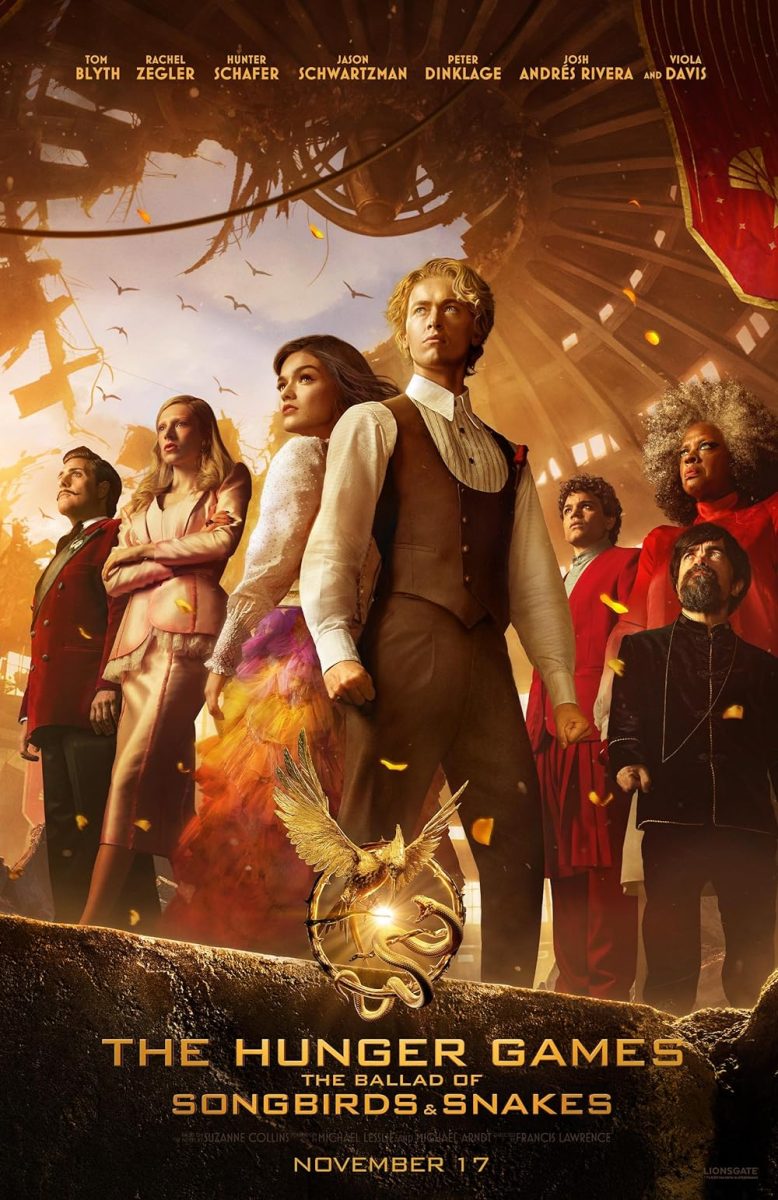Who would have thought we would be revisiting Panem in 2023, but here we are with the latest movie in “The Hunger Games” franchise, “The Ballad of Songbirds and Snakes” released Nov. 17.
“The Ballad of Songbirds and Snakes” serves as a prequel for President Snow, set 64 years in the past during the 10th annual Hunger Games. President Snow (Donald Sutherland in the original series), now known as Coriolanus or Coryo Snow, played by Tom Blyth, is a student at the academy in the Capitol. For the first time ever, senior academy students will be tasked with mentoring the tributes for the 10th annual Hunger Games. Coryo Snow was assigned the female District 12 tribute Lucy Gray Baird, played by Rachel Zegler. Together, they utilize Lucy Gray’s singing talent to win over the Capitol’s heart, but Snow does not know that, in the process, Lucy Gray is winning his heart as well.
This movie had big shoes to fill within “The Hunger Games” franchise and thrives with Francis Lawrence returning to direct. The movie maintains the same tone and aesthetic of the previous films, but expands on it in the right way. It succeeds in showing a post-rebellion Capitol, which is in the process of rebuilding to the stature and luxury it holds 64 years later. At a skeletal level, the aesthetic it creates is a blend of the future and various 20th century periods.
What makes this movie is not only the production, but the cast. The movie is filled with young talents who leave you wanting to see more.
Blyth does an incredible job portraying President Snow’s villain origin story. By the end of the movie, you have witnessed the catalyst of his tyrannical future. Blyth is not only successful in his own interpretation of Coryo Snow, but by the end of it, carries himself in a way that is very reminiscent of Sutherland’s characterization of President Snow.
Zegler’s love for the novel is what raises her performance. It is clear from her opening scene the level of care and understanding she has for Lucy Gray. Lucy Gray is a performer forced to survive, and no other actor could have done what Zegler did.
Somebody who is not talked about enough is Hunter Schafer, for her portrayal of Tigris, Snow’s cousin. While Schafer does not have many scenes, she shines in all of them. Tigris is pivotal in Snow’s descent and a throughline to pay attention to during any rewatch.
With an expanded runtime, viewers would be able to sit with characters and watch relationships grow, rather than just hitting core plot points.
Jason Schwartzman as Lucretius “Lucky” Flickerman serves as a predecessor to Stanley Tucci’s Caesar Flickerman and is just as, if not more, hilarious. As host, his one-liners are vital in the Capitol’s enjoyment. They call attention to just how much the Hunger Games are meant to be a spectacle and desensitize viewers to the violence.
It goes without saying that both Viola Davis and Peter Dinklage command every scene they are in. Davis appeared to have fun with her character Dr. Volumnia Gaul, the head gamemaker for the Hunger Games, by leaning into the sinister and kooky nature of the character. Dinklage played Dean Casca Highbottom, the dean of the academy, whose vendetta against Snow was present throughout and had a worthwhile resolution that highlighted Snow’s transformation from beginning to end.
A complaint would be that characters like Sejanus Plinth, played by Josh Andrés Rivera, and Clemensia Dovecote, played by Ashley Liao, did not get enough screen time. Both actors captured the essence of their characters and were perfect catalysts for events, but key elements in both of their stories were severely missed in the film. This shows the limits that come with adapting a book into a movie: a lot of details cannot make the final cut.
In the meantime, it’s a given that the odds are always in the favor of “The Hunger Games” franchise.
For example, key motivations or origins that explain future actions are absent, though some could be just implied. The most important one being the mockingjays, which is hinted at but not focused on enough considering the symbolism they hold in the franchise.
This can only be because of the runtime. The movie is broken into three parts, which helps tremendously with the pacing. The source material by Suzanne Collins is over 500 pages, and director Francis Lawrence has been adamant on not wanting to split the movie into two, like “The Hunger Games: Mockingjay” films.
While the movie hits all the book’s major plot points in its runtime of two hours and 38 minutes, it leaves more to be desired. With an expanded runtime, viewers would be able to sit with characters and watch relationships grow, rather than just hitting core plot points. Many fans agree and are calling for the release of a rumored three-hour and 40-minute cut.
Despite all of this the movie contends with the other movies in the franchise. The promotion of this movie has been on par with the other movies and even more engaging. The cast has had to live up to the banter between Jennifer Lawrence and Josh Hutcherson and have succeeded with a limited amount of time.
The movie almost received no promotion, but was granted a SAG-AFTRA interim agreement prior to SAG’s strike ending, which allowed for premieres and press. Since then, the promo has been entertaining. The bond between the cast has been on full display from behind-the-scenes photos and videos, and press junket videos.
This movie has only fueled the need to revisit all things Hunger Games, from the books to the movies. This prequel has only added more depth to the story and easter eggs to be found. The movie will certainly reward each rewatch.
In the meantime, it’s a given that the odds are always in the favor of “The Hunger Games” franchise. And viewers alike can only hope that Suzanne Collins is struck with inspiration once more, so that the world of Panem can be revisited again in the future.


